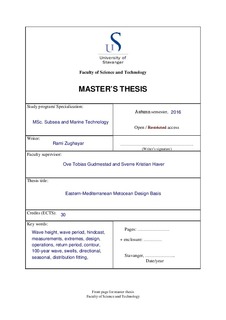| dc.description.abstract | Energy is one of the basic requirements of sustainable development of civilizations. Mankind is moving further to harsher environments, e.g. marine and arctic environments, to sustain energy production. Technology evolution is continuously opening new frontiers, potentials and of course more challenges to overcome. Alike onshore operations, offshore developments require a certain safety level to be maintained. A safety level that limits the risks related to health, environment and assets. One basic requirement for achieving that safety level may be simplified as: understanding the environment actions caused by waves, winds and currents, and building marine structures that can handle the worst conditions. Commonly used safety levels according to Norwegian Standard NORSOK N-003 are pre-defined by annual exceedance probabilities of 10-2 (return period of 10^2 years) and 10-4 (return period of 10^4 years). International Standard ISO 19902 refers to them as the return periods of the ultimate limit state design (ULS) and the accidental limit state design (ALS) respectively. Starting from the defined safety levels, Extreme environmental states (e.g. wave height) and loads corresponding to these levels can be calculated.
Ocean waves (or sea waves in this case) are irregular and random by nature, wave data or wave model are essential for predicting the ocean state. In this thesis two kinds of wave data from the Eastern-Mediterranean are used, hindcast data and measurement data. First of all the hindcast validity is checked versus the measurements. The hindcast data, then, is used for two main things, general description of the sea-state and description of the design sea-state (i.e. the
100-year and 10000-year extreme sea-states). Sea-state is described; directions, seasons, locations and swell waves are analyzed.
NORSOK standard defines the “design storm concept” which states that instead of performing a full long-term response analysis, the extreme actions and actions effects can be estimated directly corresponding to annual exceedance probabilities, e.g. 10-2 or 10-4. There are a number of different techniques but there is no theoretical best method for estimating the extreme seastate. DNV recommended practices refer to few statistical methods. Among the different recommended extreme estimation methods, an interest in the uncertainties and their significance was developed that lead to a focus on extremes uncertainty assessment. Extremes are estimated, uncertainties are evaluated, and environment contours are presented. | nb_NO |
